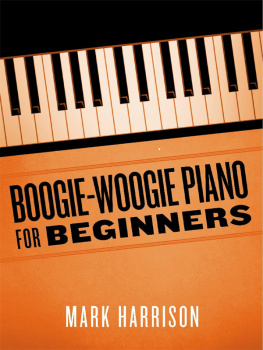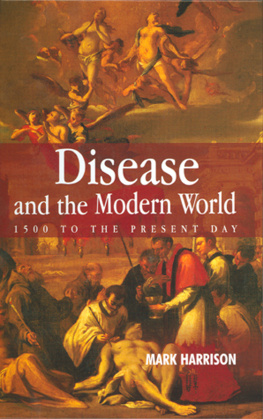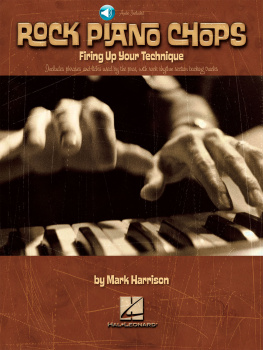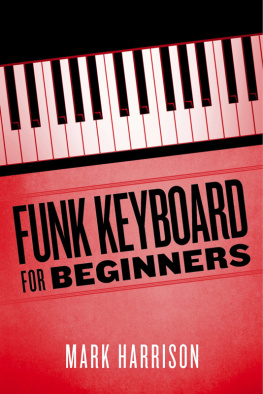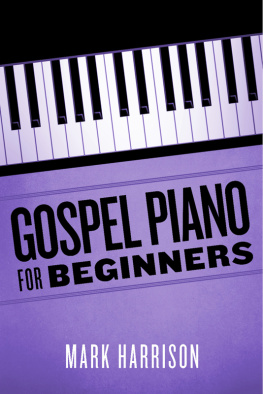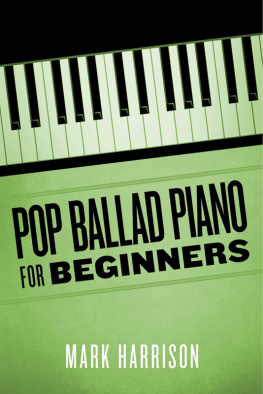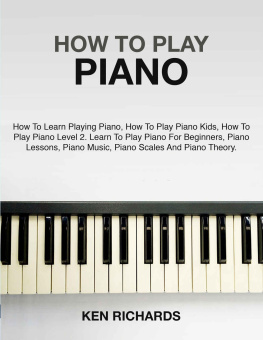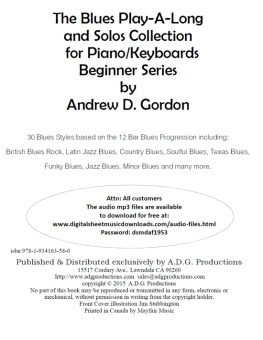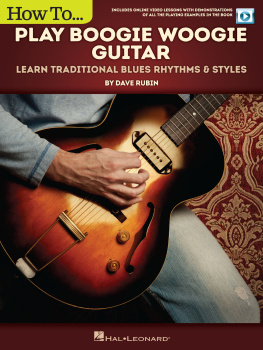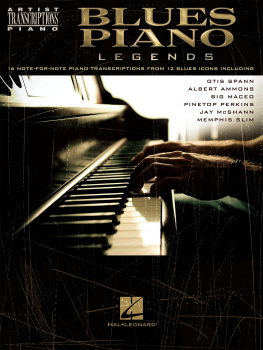
Published by: Harrison Music Education Systems, P.O. Box 5068, West Hills, CA 91308, USA
Publication date: 05/01/13
Copyright: 2013 Mark Harrison
ISBN Number: 9781626757141
For information on our music education books and CDs, downloadable products and packages, and private on-line lessons, please visit our website: www.harrisonmusic.com
Contents
Introduction
Welcome to Boogie-Woogie Piano For Beginners. This book will start you on the road to playing authentic boogie-woogie piano, even if you are a complete beginner. Youll get started right away by learning some essential boogie-woogie patterns which sound great when playing solo piano, or on your first (or next) gig with a blues band!
Please email us at with Boogie-Woogie Piano For Beginners in the subject, to receive your FREE mp3 audio recordings of all the music examples in this book! Most of the audio recordings feature a rhythm section on the left channel, and the piano on the right channel. To play along with the band, turn down the right channel to eliminate the recorded piano. To hear the piano part for reference, turn down the left channel to eliminate the rhythm section.
Along with your free mp3s, you will also receive free pdf versions of all the music notation examples. So if your e-reader does not display the notation examples clearly enough, you can use the pdf versions as a convenient alternative.
Section One Starting Out with the Left Hand Pattern
Like a lot of piano blues, the foundation of a great boogie-woogie piano performance is a strong and steady left hand pattern. Our first boogie-woogie piano left hand pattern uses the chord tones within a C major triad (C, E and G) and a swing eighths rhythmic feel, as follows:
Example 1

These notes are quite low on the piano, and so we need ledger lines below the bass clef staff in this case. Just remember that the first note in this example is C, which is two octaves below Middle C (in the middle of the piano keyboard). This note is repeated on beats 1 and 3 of each measure. The other notes are G and E, played during beats 2 and 4 of each measure.
Be sure to check out the mp3 audio track for this example (especially if your note reading is at a beginning level!) Also the fingering numbers are shown on the staff: the pinky is playing the C, and the thumb and middle finger are playing the G and E respectively. The fingering simile note in the second measure, means that the fingering is the same as for the first measure.
The eighth-note rhythmic counting (1 & 2 & 3 & 4 &) is also shown above the staff. This is how eighth notes are counted, with the 1, 2, 3 and 4 falling on the downbeats, and the &s in between falling on the upbeats. In this swing eighths example, all of the &s actually land two-thirds of the way through each beat, giving the rhythm a more loping or shuffle type of feel. Count along to the mp3 audio track accompanying this example, to get comfortable with this rhythmic idea. All of the music examples in this book have a swing eighths feel, which is very common and traditional in boogie-woogie piano styles.
Section Two - Adding Triads in the Right Hand
In the next example weve added a simple C major triad (three-note chord) in the right hand, over the previous pattern in the left hand:
Example 2

Note that the left hand pattern and fingering are the same as for Example 1. Above this in the right hand, we have the C major triad played as whole notes (which last for four beats each). The right hand fingering is also shown, with the thumb, middle finger and pinky playing the notes C, E and G respectively.
As you play this example, focus on getting the left hand pattern steady and consistent, with the right hand triads landing on beat 1 of each measure. You can count through it in a similar way to Example 1 (1 & 2 & 3 & 4 &) if needed. Again if you are unsure about how this example sounds, check out the accompanying mp3 audio track. Then when youre ready, play along to the rhythm section track on the left channel!
Theory note: The C major triad is built by taking the first, third, and fifth degrees of a C major scale. The third of the chord (E) is a major third interval above the root, and the fifth of the chord (G) is a perfect fifth interval above the root. The chord symbol above the staff (C) denotes a C major triad.
Section Three - The Twelve-Bar Boogie-Woogie Progression
Boogie-woogie can be thought of an an early blues piano style, and so a lot of boogie-woogie tunes use the twelve-bar blues chord progression. This progression is created from the I, IV and V chords within a key (this is equivalent to building chords from the first, fourth and fifth degrees of a major scale). First well need to review a little bit of theory to see where these chords come from:
Example 3

In this example, the empty noteheads spell out a C major scale (C-D-E-F-G-A-B-C from left to right). Above the first, fourth and fifth degrees (C, F and G) we have built C major, F major and G major triads respectively.
Theory note: The C major scale (like all major scales) is spelled using whole-step, whole-step, half-step, whole-step, whole-step, whole-step, and half-step intervals in an ascending sequence. These C, F and G major triads are all diatonic to the key of C, meaning they are all contained within the C major scale.
Next well develop the boogie-woogie pattern from Example 2 over a twelve-bar blues progression in the key of C, using the above C major, F major and G major triads:
Example 4

This progression contains twelve bars or measures, and is the standard form used for a great many boogie-woogie and blues songs! This basic twelve-bar form consists of three four-measure sections, which start with the I chord (C), the IV chord (F), and the V chord (G) respectively. Make sure that you look ahead for the hand position changes needed - this will help you play the pattern in tempo, rather than pausing at the point of chord change to figure out where to go!
Each right hand triad in Example 4 is in root position i.e. the root of the chord is on the bottom in each measure. Later well see examples of using chord inversions (where the root is no longer the bottom note), which will give us some different options for connecting between chords.
Again when youre ready, play along with the rhythm section on the left channel of the audio track, to get comfortable with this example.
Section Four Creating Right Hand Patterns from Triads
Although the right hand triads used in Example 4 work fine in a basic boogie-woogie setting, more interesting and stylistic results can be achieved by playing single-note patterns in the right hand, which are based on triads (or larger chords). A simple starting point is to play an arpeggio of the chord (i.e. playing the chord tones in a broken chord style), and we can also add neighbor tones which are adjacent notes either above or below a chord tone. The following example uses neighbor tones which are a half-step below (and lead into) the 3rd of each chord, as follows:
Next page
